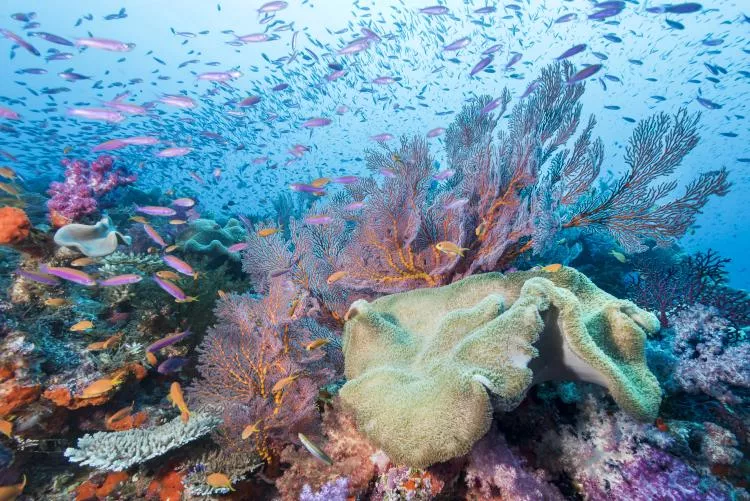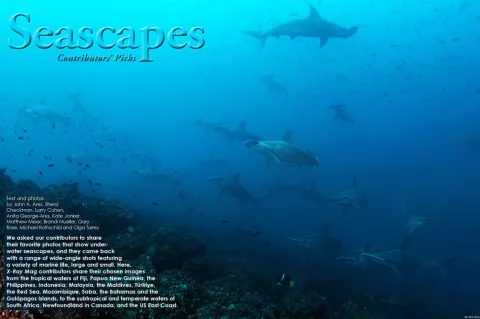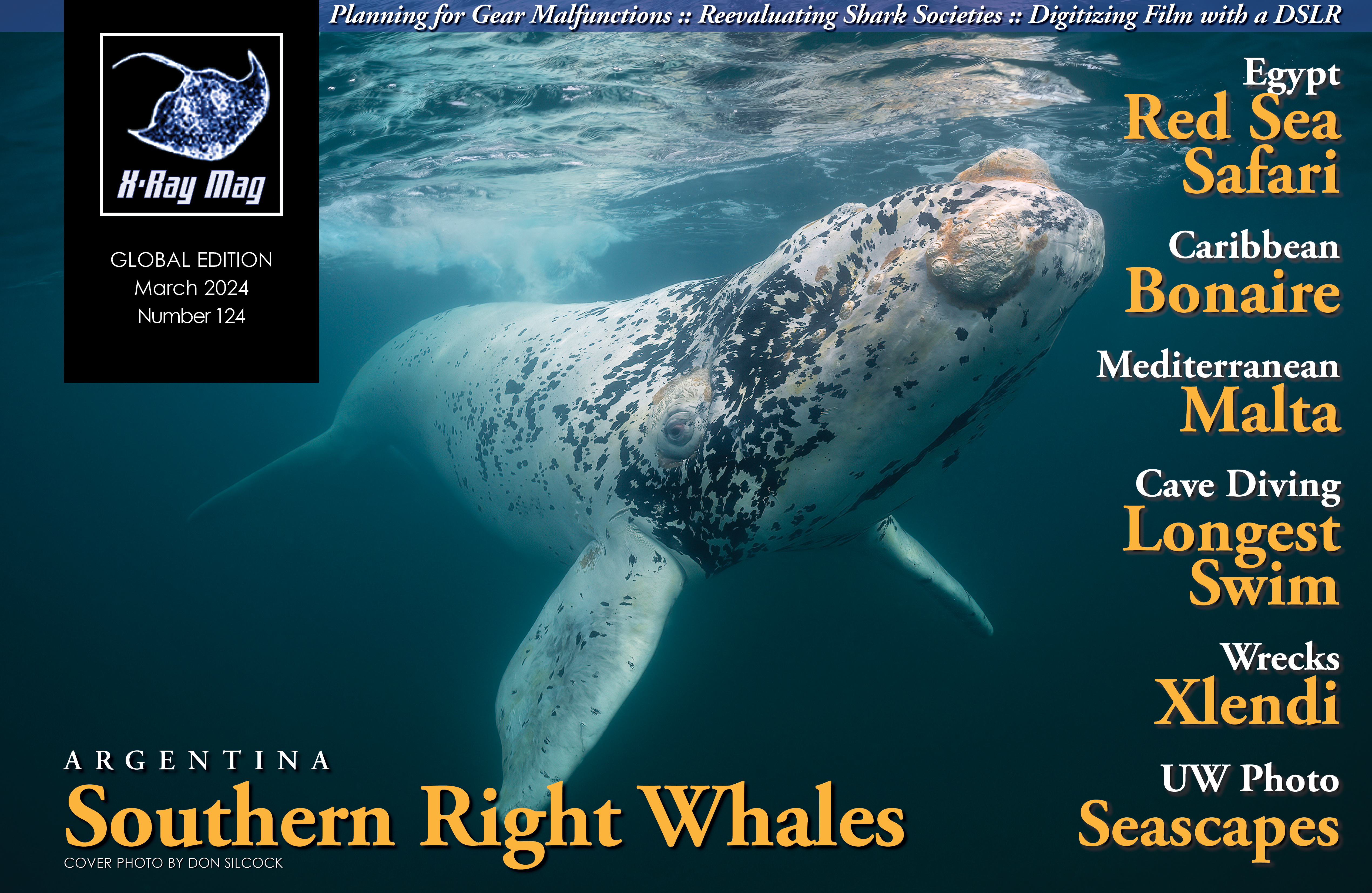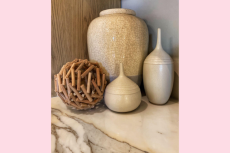We asked our contributors to share their favorite photos that show underwater seascapes, and they came back with a range of wide-angle shots, featuring a variety of marine life large and small.
Contributed by
(To see all the images in the article, please scroll to the end and download the PDF.)
Here, X-Ray Mag contributors share their favorite images from the tropical waters of Fiji, Papua New Guinea, the Philippines, Indonesia, Malaysia, the Maldives, Türkiye, the Red Sea, Mozambique, Saba, the Bahamas and the Galápagos Islands, to the subtropical and temperate waters of South Africa, Newfoundland in Canada, and the US East Coast.
The Colorful Waters of Fiji
Text and photos by Matthew Meier
The term “seascape” can be interpreted in different ways and every individual will have their own definition, but, for me, I envision wide expanses of colorful coral reefs, exploding with life. In my experience, Fiji has some of the most “fishy” and vibrant reefs on the planet, so when this request hit my inbox, I immediately knew where to start searching in my library of images.
The Bligh Waters, located north of the island of Viti Levu and Rainbow Reef in the Somosomo Strait between the islands of Taveuni and Vanua Levu, is my favorite destination to witness a kaleidoscope of multicolored soft corals and abundant reef fish. The only real issue I had was narrowing the selection down to just four photos, as I try to showcase the brilliant variety and breadth of life that can be seen on these spectacular reefs. Visit: MatthewMeierphoto.com
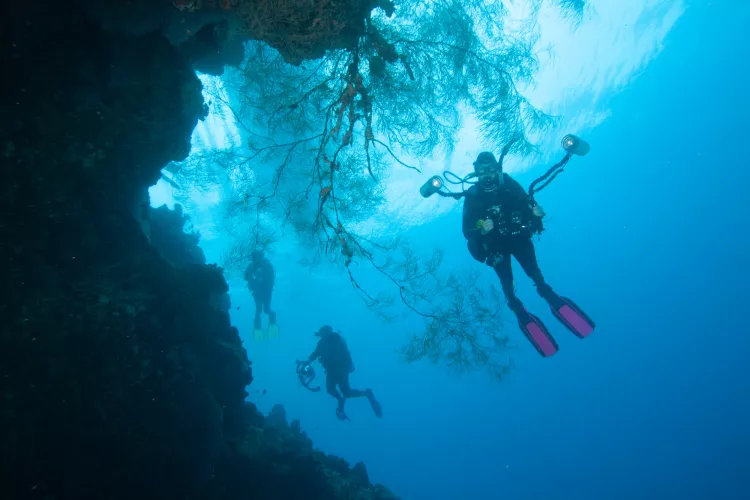
Fiji and the Philippines
Text and photos by John A. Ares
When you see them, seascapes produce a “wow” reaction. Not every dive site has a “wow” seascape, but you experience a sense of grandeur when in the middle of the scene.
The E-6 grotto in Fiji was one of the most fantasy-fulfilling dives ever (Photo 1). With striking colors, gentle curves of soft corals arching overhead and ample room to swim through, this was one gorgeous dive.
The great white shark behind a wall of fish produced a 3D experience in Photo 2. The fish in front were about six feet away from the me and barely masked the shark lurking behind, maybe 10 to 15ft farther.
In Photo 3, the wall of fish underneath the boat was composed of thousands of individuals. Our shark cage was gently swinging back and forth, creating a different view every few seconds. The visibility was nearly 200ft.
Three divers near a cavern off Sumilon Island are shown with soft corals in Photo 4. Two of the divers were ascending and changed positions during my sequence of photos. I took about four shots, and this one was the best. Sumilon has exceptional swim-throughs and can have strong currents. Visit: JohnAres.com
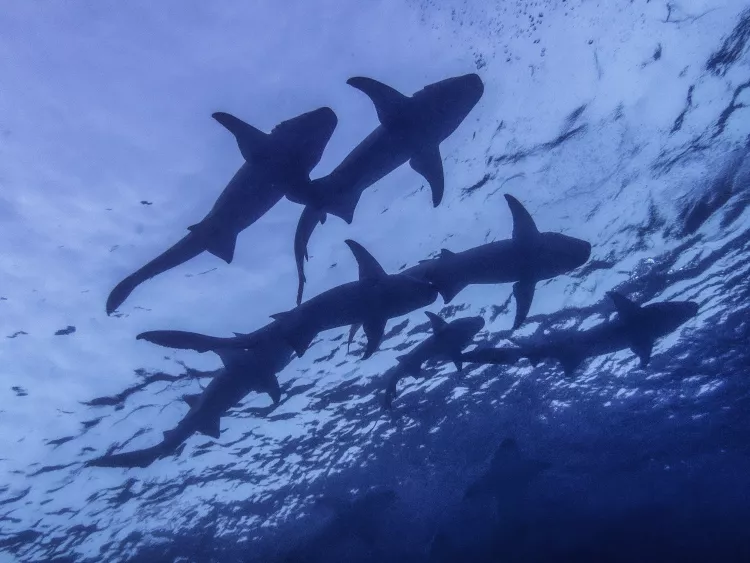
The Maldives
Text and photos by Sheryl Checkman
The sea is an infinite, deep blue space that is home to creatures both big and small, and to which we divers are allowed to visit. Water comprises approximately 71% of the Earth’s surface. The seascapes I chose for this feature show the relationship between the water, some of the sharks that live in it, and we humans who come to observe them. These photos were all shot with ambient light.
On a recent trip to the Maldives, I had several opportunities to watch nurse sharks swimming through the water in ways I have never seen before.
At Dhiggiri in the Vaavu Atoll, I watched from a unique perspective as a large tawney nurse shark, and its companion sharksucker (or remora), swam directly above me. During a nurse shark dive at Alimatha, also in the Vaavu Atoll, hundreds of nurse sharks, smelling the human-provided bait, arrived en-masse, as one lone diver swam in their midst. Also, at Alimatha, I looked up from below to see at least seven nurse sharks silhouetted against the surface above.
And, while hooked in at Moo Fushi Corner in South Ari Atoll, I watched as a whitetip reef shark rested on the sand—a position I am more used to seeing with nurse sharks. Appearing to smile at me, I think it was okay with my coming to visit and enjoying this seascape that this shark called home. Visit: Instagram.com/SherylCheckman
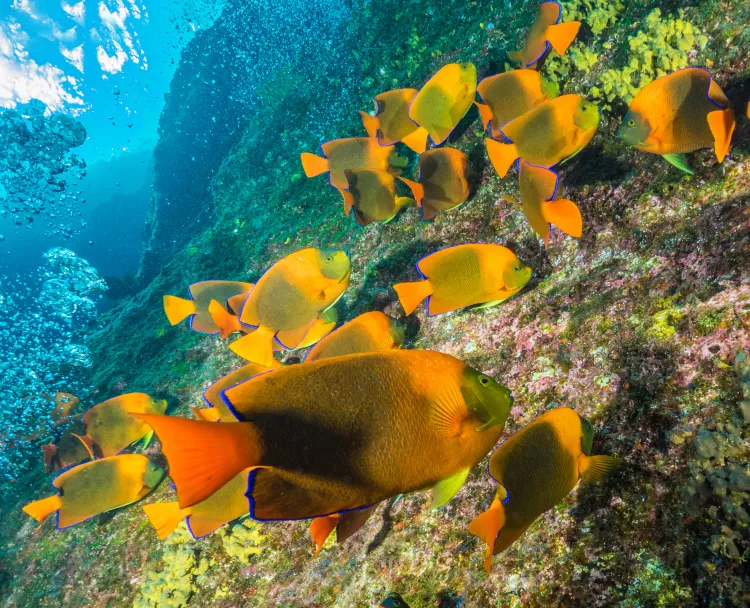
Papua New Guinea, Mexico & Türkiye
Text and photos by Larry Cohen
Underwater photographers have the privilege of experiencing different seascapes around the world. The main feature might be coral reefs with colorful sponges or interesting rock formations. One of my favorite places to view seascapes is Papua New Guinea. When diving on Elaine’s Reef, I wanted to capture the beauty of the whip coral on the wall. As I pushed the shutter button, two divers swam into the frame. Back on the boat, they apologized for getting into my shot. I then showed them how this accident added depth to the image.
The Arch is an exquisite dive site in Papua New Guinea’s Kimbe Bay. This offshore site is reached via liveaboard boat. The giant sponge inside the arch makes a spectacular seascape photograph.
In Mexico, the Revillagigedo Archipelago off the western coast is known for giant manta rays, sharks and other large animals, but the area’s seascapes are also magnificent. There are many fascinating walls, pinnacles and small marine life. While circling the wall around Socorro Island, I spotted a school of Clarion angelfish. This colorful fish is only found off the Pacific coast of Mexico. They are popular aquarium fish but cannot be taken legally. Tank-raised juveniles are sold for as much as US$3,000.
In the Mediterranean, the Three Islands is a dive location near the resort town of Kemer in Türkiye (Turkey). At one dive site, there is a small underwater cave, the entrance of which is a hole in the side of the island. The rocky seascape is not colorful but intriguing, as one swims into the entrance. Visit: liquidimagesuw.com
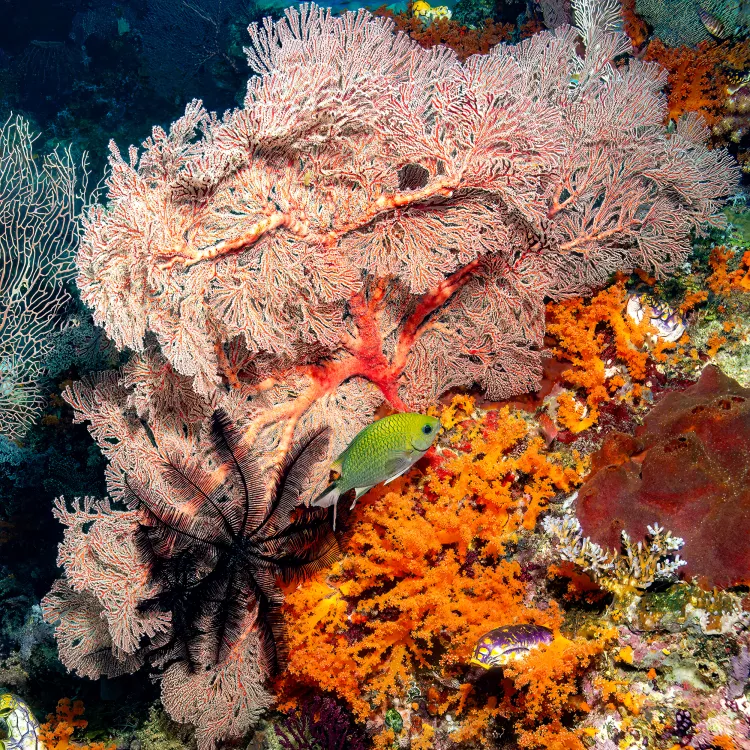
Raja Ampat
Text and photos by Anita George-Ares, PhD
My favorite seascapes were taken off the small island of Daram, located near the prominent Misool Island in South Raja Ampat, Indonesia. Photo 1 was taken at the Andiamo dive site. Photos 2, 3, and 4 were taken at the Warna Berwarna dive site. Warna Berwarna is an Indonesian name meaning “beautiful colors.” This site is characterized by numerous large sea fans and dense schools of fish.
These seascapes incorporate some important elements in landscape composition: vibrant colors, texture, repetition, depth and layers. In Photo 1, a ternate chromis poses by a crinoid, a rose-colored sea fan and a carpet of orange soft corals. In Photo 2, a single red sea fan dominates the seascape, while in Photos 3 and 4, the repetition of sea fans creates interesting patterns and symmetry.
The seascape in Photo 4 was characterized by white sea fans against blue water. Converting the image to black and white added structure and contrast while highlighting the beauty of the sea fans and school of fusiliers. The image was converted to black and white using Nik Silver Efex Pro 2 software. Visit: facebook.com/profile.php?id=100016947967639
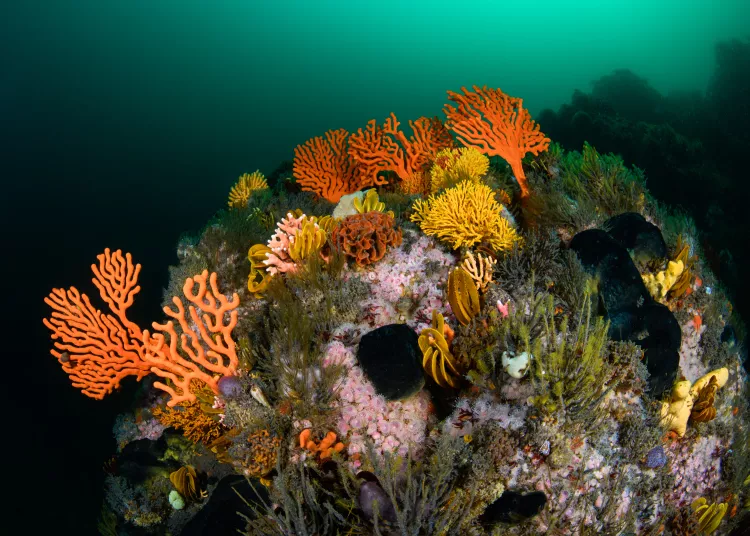
Distinctively Different
Text and photos by Kate Jonker
When I think of seascapes, those of the Red Sea, Mozambique and False Bay in South Africa immediately come to mind, as they are each unique and distinctive—easily recognisable in underwater images.
In the northern Red Sea, vibrant hard coral reefs provide a kaleidoscopic setting for diverse marine life, including schools of fish, sharks and turtles. For me, the large sandy plateau behind Shark and Yolanda reefs, adorned with pale soft corals and schools of unicornfish epitomises a mesmerising seascape.
Venturing to the southern Red Sea reveals caves, coral reefs and steep walls adorned with vibrant soft corals, gorgonian fans and sea whips. Swimming alongside the steep-sided walls, where several species of sharks, dolphins and large fish roam, is an awe-inspiring experience.
Closer to home, Mozambique’s flat reefs of fossilised sand dunes offer a stark contrast. Teeming with colourful fish in shallow waters, and attracting sharks like hammerheads in the deeper reefs, Mozambique promises an exhilarating and memorable diving experience.
Returning to False Bay in Cape Town introduces cooler waters, kelp forests and rocky reefs. Home to seals, small sharks and vibrant invertebrates, the eastern coastline of False Bay captures my heart with its rambling kelp forests and vibrant reefs.
Whether it is the warm allure of the northern Red Sea, the dramatic walls of the southern Red Sea, the wild reefs of Mozambique, or the marine-rich ecosystems of False Bay, each seascape ensures a captivating, diverse and unique underwater adventure for diving enthusiasts and underwater photographers. Visit: katejonker.com
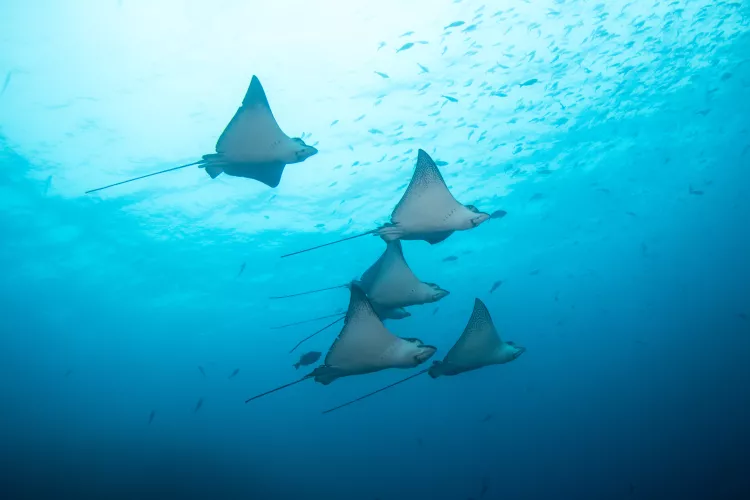
The Galápagos Islands
Text and photos by Brandi Mueller
The topic of “seascapes” strikes me as potentially all-encompassing when we are talking about wide-angle underwater photography. It seems to me that almost every image we take underwater is a seascape of some sort, but I decided to focus on images from the Galápagos Islands in Ecuador.
The islands are known for big animals in big scenes. While not tropical, sponges and temperate corals cover rocky terrain and create interesting backgrounds that support, but do not distract, from the apex animals that steal the show.
Playful sea lions swirl around divers, the shell of a cruising sea turtle serves as a place for fish to rub parasites off their bodies, and colorful fish swim by like a sudden pink rain shower. Sometimes, the vast blue waters here are the perfect backdrop for massive schools of hammerheads and eagle rays. These scenes are some of the first things that come to mind when I consider seascapes. Visit: brandiunderwater.com
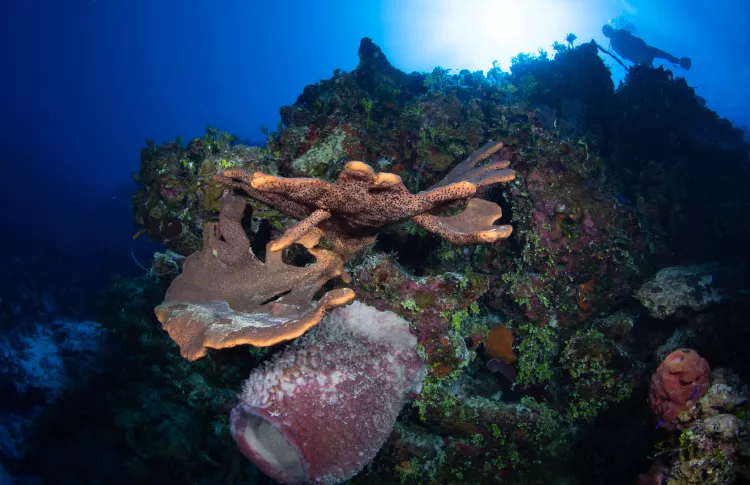
Define Your Subject
Text and photos by Gary Rose, MD
Many first-time and beginner underwater photographers shoot their initial photographs of “all-encompassing” seascapes. They then progress to taking photos of individual fish. With a little time, they learn that the deeper they go, there is an inverse proportion to the amount of sunlight that penetrates to the depths with an accompanying loss of the warm colors—yellow, orange and red. It is at about this time in their photographic skills development, that they learn to focus on, highlight and define the subject(s) being photographed.
Photo 1 is an example of a poorly planned seascape with a lionfish. My intention was to capture the subject (the lionfish) in its habitat. However, the lighting highlighted an excessive amount of the surrounding coral, which distracts from the subject. Then, the viewer’s eye is strongly drawn to the towering sponges in the background. The lionfish is lost in all of the surrounding clutter. It would have been much more effective to capture the lionfish from the side, creating negative space behind it, which would then have separated it from all of the surrounding jumble and distractors.
At first glance, the multiple hues of the tropical blue sea in Photo 2 create a beautiful negative background space, which highlights the alluring colors and topography of this gorgeous coral formation. The entire coral head is in sharp focus. The muted focus of the background corals emphasizes the texture and tranquil colors of the coral head. I often include a diver (lower left background) in my photos to create depth of field and human interest.
The very large elkhorn coral, which is the featured subject of Photo 3, is suspended from a hanging ledge on a very deep wall. This creates suspense, adds drama, and with the addition of the diver, the dark blues and plunging wall in the background, the viewer is given the feeling of being suspended in the water, floating within the current as it sweeps by the wall.
On the other hand, the very sharp resolution of the elkhorn coral in Photo 4, the adjoining and muted giant barrel sponge, the wall soaring up and extending to the diver (upper right corner), and the very bright sunburst, all work together to create a very startling 3D effect. This is especially apparent when this photo is viewed on a wall in a gallery, from a few feet away.
Photos 3 and 4 were shot within a few minutes of each other, at different angles, at the same location, on a deep descending wall. Most of the same elements are included in both compositions and are wonderful examples that enable a comparison of how different viewing perspectives can completely change the flavor of a photograph.
It is imperative that underwater photographers always think about and define what it is that they are shooting. Once the subject is determined, then the creativity and art begin. Visit: garyrosephotos.com
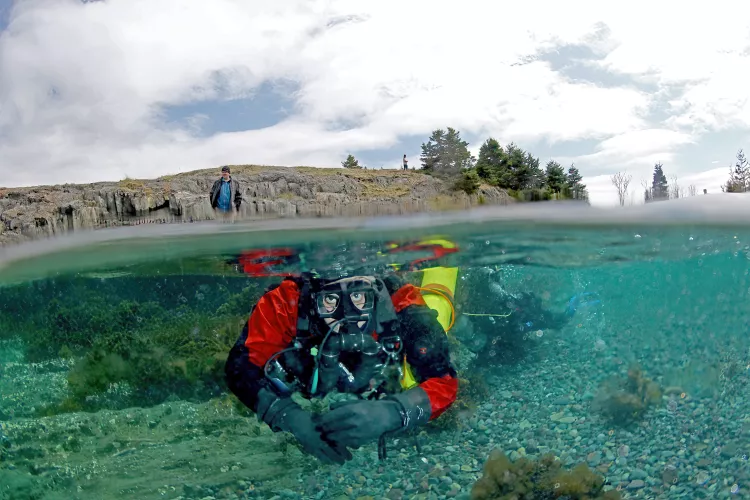
Over-Under Shots
Text and photos by Michael Rothschild, MD
I use a compact 100mm dome port for my fisheye lens, which is better for travel when luggage space is at a premium. One tradeoff, compared to a larger dome, is the limited ability to do over-under photos, so I do not do a lot of them. But this topic lends itself well to these shots. Over-under images are a great way to depict the boundary between two worlds—sea and surface. These photos evoke the story of the two transitions that are part of every dive: splashing in at the beginning, and breaking the surface at the end.
Each of these images uses the air-water interface to make the sea itself the subject, as opposed to its usual role as background. Photo 1 shows a diver poised to reboard a dive boat. A key compositional element here is the ladder that just let him haul his sidemount rebreather to the deck. Photo 2 shows the same diver in the shallows of a shore dive, dwarfing the lone surface observer in the background. And Photo 3 shows a harbor shack, its bright red paint contrasting with the blues and greens of the seagrass and rocky ledges, over which it was built. Visit: dive.rothschilddesign.com
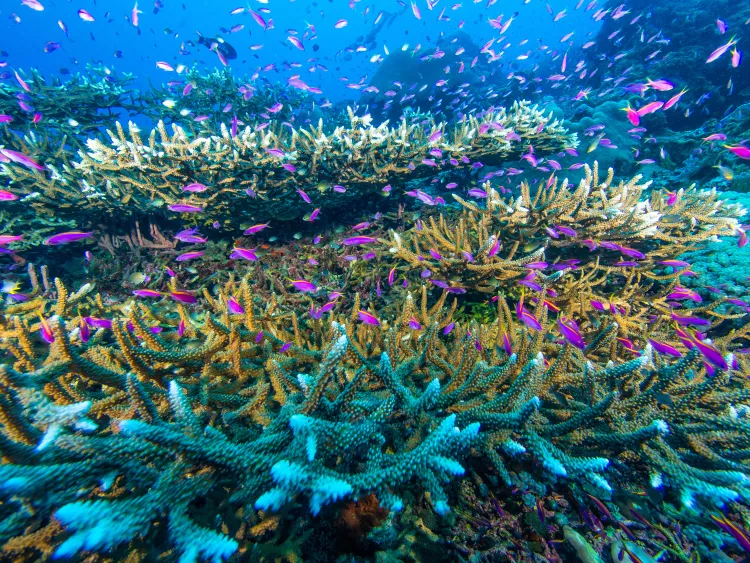
Mexico, Malaysia and Papua New Guinea
Text and photos by Olga Torrey
In Mexico, Cozumel is well known for clear visibility on the lush reefs. There are plenty of opportunities for photographers to photograph various fish, eels, turtles and other marine life. When I swam into a large school of tropical grunt fish, I was glad I had a fisheye lens to capture the whole school around a large formation of coral reef. On another day in Cozumel, I saw a bigger school of tropical grunt fish. I used a wide-angle lens to capture about 200 adults and juvenile grunt fish.
In Sabah, Malaysia, while diving under the pillars in the Celebes Sea, I encountered a large school of silverside fish. It looked like an enormous moving cloud, gracefully morphing into different shapes. At that time, I wished I had a fisheye lens to show the full scale of the silverside fish school.
The staghorn coral (A. cervicornis) is an endangered species that has declined by 90% due to coral disease and bleaching. While diving in the Pacific Ocean in Papua New Guinea, I saw a healthy abundance of coral reefs with different fish species occupying this species of coral as their home. Visit: fitimage.nyc

